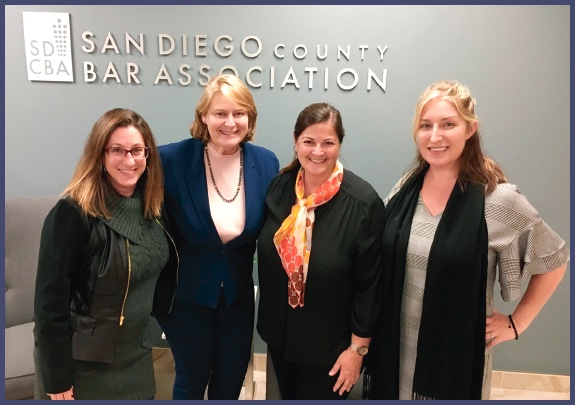This article was originally published in the Sep/Oct 2021 issue of San Diego Lawyer Magazine.
By Holly Amaya

Four in a row. For the first time in its history, four successive female presidents have served the San Diego County Bar Association and its members.
These women — Kristin Rizzo, Lilys McCoy, Johanna Schiavoni, and Renée N.G. Stackhouse — hail from diverse backgrounds. Their experiences span discrete practice areas. McCoy was the Bar’s first woman to serve as president who is openly lesbian; Stackhouse is only the second Latina to hold the role. And their faces punctuate a virtually uninterrupted cadence of male presidential portraits lining the Bar Center’s walls.
“Four consecutive female presidencies at the SDCBA represents a consistency of female leadership at all levels within the organization,” Rizzo said. “Female attorneys have paved the way for many years toward the goal of gender equity in our legal community, and at the SDCBA, female leadership — both at the board level and at the presidential level — has been prevalent for quite a while. With consecutive female presidents year over year since 2018, I am gratified that the path toward gender equity at top levels within the SDCBA is well-paved for future female leaders.”
But the groundwork that led to this moment began back in 1985, when Hon. Melinda Lasater, now a Superior Court judge, became the first woman to hold the role. Ten years later, in 1995, Regina Petty was the first Black woman to serve as president.
“When I was president-elect, I stopped by the Bar Center with my then 13-year-old son,” McCoy said. “He walked into the main boardroom, stood in front of the wall of photographs of SDCBA presidents, and studied it. He then turned to me and said, ‘Wow, no women for … so many years … until 1985.’ I will never forget that moment.”
And for Stackhouse, “When I decided to run for president-elect, some folks cautioned me that there had been a lot of women presidents recently (three) and it might count against me,” she says. “This was usually followed by the sheepish admission that three wasn’t very many — and look at how many men in a row had been presidents.”
Undeterred, Stackhouse ran for president anyway, and won. Now she is leading a board where 11 of the 19 directors are women. (At the time this article was written, 11 of 19 Directors were women. In September, Marissa Bejarano was appointed as a Superior Court judge and resigned her position on the Board. Thus, the current Board is now 18, with 10 women Directors.)
“This should be an everyday thing,” Stackhouse says. “Why isn’t the question for the board ‘Who do we want to lead the organization?’ versus ‘How many women have there been? Maybe it’s time for a man again.’ Let alone making space for a non-binary President.”
This succession is certainly a turning point in the Bar’s 122-year history. Consider, for example, the experience of former Congresswoman Lynn Schenk, who went on to co-found Lawyers Club after being deterred from joining various SDCBA committees by the then-Bar president.
“He said there was already ‘one girl’ on the Bar Board of Directors — wasn’t that enough?!” she said in a 2007 interview. And that experience, according to Schenk, “was really the impetus for us to start Lawyers Club; they didn’t even want our volunteer time.”
Change, the Bar’s last four presidents agree, is incremental. As noted previously, in 1985 Hon. Melinda Lasater became the first female SDCBA president. And six years later, three San Diego courts were led by women: the Superior Court by Judge (now Justice) Judith McConnell, the Municipal Court by Judge Patricia Cowett, and the Federal District Court, Southern District of California by Judge Judith Keep.
Today, the SDCBA Board of Directors is among the most diverse in the organization’s history — and major advances were made under each of the last four presidents to make that happen.
According to Schiavoni, a coterie of members who were involved in local affinity bars in 2016 joined the Board together and made a strategic commitment to advance a diversity and equity agenda at the SDCBA. Diversity, equity, and inclusion (DEI) was a critical part of their campaign — and they acted on it, adopting a diverse speaker policy, and overhauling the Bar’s diversity committee.
“As that has funneled up through the bar association, it’s resulted in multiple tangible policies that we advanced and it has created a more positive and welcoming culture organizationally,” she says. “It has also encouraged people to run for the board who otherwise didn’t think it was the place for them.”
This year, with Stackhouse as president, the Bar updated and relaunched its Diversity Pledge, an effort designed to encourage law firms and organizations to put their proverbial money where their mouths are in terms of recruiting, hiring, and retaining diverse attorneys. And over the past two years, both Stackhouse and Schiavoni led crucial efforts to issue public-facing statements on issues impacting diverse communities, including anti-AAPI violence and the murder of George Floyd.
“The work to be more inclusive, transparent, and equitable should always be a focus of the legal community,” Schiavoni says. “It’s tangible and also symbolic that there have been four women in a row — and that should never be the end of the conversation in celebrating those things. It’s a long game.”
Looking past the “four in a row” marker, Stackhouse reflects on the bigger picture. “Can we do better? We should always try,” she says, noting that because ”law students and new lawyers are looking at us, we need to make sure they can see themselves in these positions. That’s the only way we drive the path toward greater equity.”
Holly Amaya is the co-founder and chief operating officer of Story Imprinting, a full-service training and communications firm. Holly has worked in a multitude of fields, including journalism, law, and public relations.